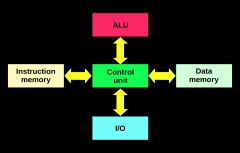![]()
![]()
![]()
Use LEFT and RIGHT arrow keys to navigate between flashcards;
Use UP and DOWN arrow keys to flip the card;
H to show hint;
A reads text to speech;
8 Cards in this Set
- Front
- Back
|
What main external and internal components will most computers have? |
> Processor > Main memory (RAM) > Buses (address, control and data( > I/O controllers linked to I/O devices |
|
|
What are the three main sections of a processor? |
The control unit (CIR, instruction decoder and control circuits), the arithmetic logic unit (ALU) and the general purpose registers. |
|
|
What is the definition of a bus? |
A set of parallel wires connecting two or more components of a computer. |
|
|
What are the roles of each of the three buses? |
> Data bus - provides a bi-directional path for data and instructions to be moved between components. The width of the data bus is usually equal to the processor's word size, but if it is less than this, then multiple memory addresses will have to be made per piece of data/instruction processed, and there will be a detrimental effect on performance. > Address bus - the address bus carries the addresses of memory (to either be read from or written to) from the processor to other components such as the main memory or the disk I/O controller. It only works in a single direction. The width of the address bus determines the maximum number of spaces in memory that are addressable by the processor with a single transmission. If, for instance, the address bus were 16 bits wide, and a 32 bit address needed to be read from, the address could still be sent in two separate transmission. > Control bus - a bi-directional bus used for transmission of command, timing and status information between system components. Control lines include: read/write commands, interrupt requests (when a device with lower priority requests access to the CPU), bus requests from devices, bus grants from the CPU and clock signals. |
|
|
What is an I/O controller and what 3 parts does it consist of? |
An I/O controller is a device that interfaces between an input or output device and the processor. It receives input or output requests, and in some cases read/write addresses, from the processor, and then sends device-specific control signals to the device it controls. It also manages data flow to and from the device. It is an electronic circuit board consisting of: > An interface that allows the controller to connect to the buses. > A set of data, command and status registers. > An interface that allows the controller to connect to the external device it controls. An interface is a standardised form of connection. One example is a USB connection. |
|
|
What is von Neumann architecture? |
The von Neumann architecture is based on the stored program concept, where programs must be resident in main memory to be executed. Machine code instructions are fetched from memory one at a time, decoded and then executed in the processor. The majority of computers today are built on this principle. |
|
|
What is the Harvard architecture? |
A computer architecture where there are physically separate memories for instructions and programs. Reasons for: The two different memories can have different characteristics, e.g. the instructions could be held in ROM while data is stored using read-write memory. Embedded systems, such as air traffic control systems, often use purpose built computers that operate in real time. As Harvard architecture can be faster than von Neumann since data and instructions can be fetched in parallel and don't have to compete for a bus, these systems may be built with Harvard architecture. |
|
|
Diagram of Harvard architecture: |

|

